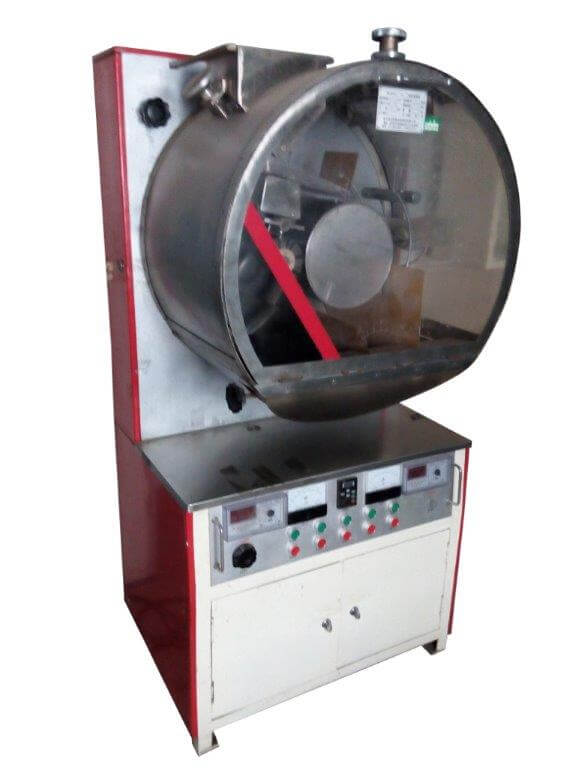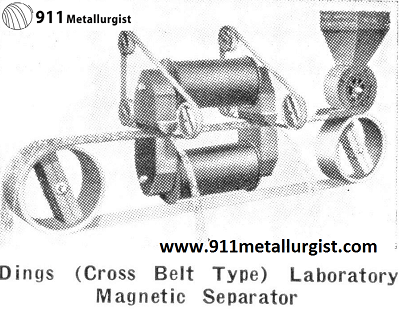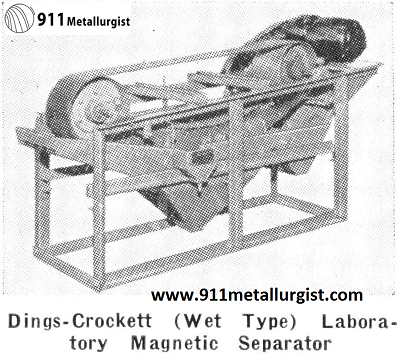Table of Contents
- Electromagnetic Separation response by Minerals
- Suspended Laboratory Magnet
- Laboratory Horseshoe Magnet
- Cross Belt Laboratory Magnetic Separator
- Laboratory Magnetic Separator: Dings Crockett (Wet Type)
- Laboratory ElectoMagnetic Separator: Dings Davis Tube Tester
- Laboratory Magnetic Separator: Stearns (Ring Type)
Starting with a mixture of any of the above minerals it may be determined whether or not they can be separated by high tension, magnetic, or gravity methods and whether any one, or a combination of “Electromagnetic Separation” methods is required. If the minerals appear in different columns they may be separated by high tension and/or magnetic methods alone. Two or more minerals appearing in the same column can be separated by gravity concentration if they have sufficient difference in gravity (usually a difference of approximately I.O).
It should be noted that grain shape and/or size may alter separation characteristics. This is sometimes a detriment and other times useful. As an example, mica and quartz may in many cases be separated by high tension due to their grain shape.
Minerals behaviour characteristics shown are from tests made in our laboratories rather than theoretical. Mineral characteristics and behaviours sometimes vary from different deposits. The behaviour of minerals not shown can usually be predicted by the behaviour of similar minerals in the below table.
Electromagnetic Separation response by Minerals

Electromagnetism by Mineral
Suspended Laboratory Magnet
Magnets of the suspended or magnetic pulley type are often advisable for use with continuous pilot test plants as the occurrence of such foreign materials as tramp iron are not unusual in ore being tested on a large scale. The use of
magnets will frequently prevent otherwise expensive and troublesome breakage in the crusher or damage to crushing rolls, with resultant shutdown and loss of testing time.
The (Suspended Type) Laboratory Magnet is usually placed above the ore conveyor preceding the jaw crusher. Width of conveyor belt, depth of ore being conveyed and average percent of foreign material to be eliminated determine the size of magnet required. This type magnet is furnished either circular or rectangular.
The high intensity (Pulley Type) Laboratory Magnet is one of the most practical, satisfactory, and economical magnets in use today. Used as the head pulley of a conveyor, the shaft of the magnetic pulley can very often be made to correspond with the shaft of the original pulley. It is only necessary then to place the magnetic pulley into the existing bearings. Magnetic pulleys are wound for either 110 or 220 volts and are furnished for direct current only. Rectifiers are available to enable use of alternating current.
Let us make recommendations for your continuous laboratory or pilot test plant.

Laboratory Horseshoe Magnet
The Alnico Horseshoe Laboratory Magnet is a small extremely powerful hand magnet. It is an alloy of aluminum, nickel and cobalt, and is many times stronger than the ordinary horseshoe magnet. It is extremely resistant to demagnetization and is affected only slightly by shock or temperatures as high as 1200°F. This magnet provides an invaluable tool for the assayer, mineralogist, and test plant operator. Minerals that are even moderately magnetic may be separated from non-magnetic material with this magnet and it is small and light enough to carry about in your pocket.


Cross Belt Laboratory Magnetic Separator
The Dings (Rowand-Wether- ill) Magnet Separator (Cross Belt Type) is a super-high intensity machine for feebly magnetic materials. It finds its principal application on finely divided materials which have a tendency to adhere to rolls and on minerals of similar magnetic susceptibility where clean cut separations of a series of magnetic products are desired. Results obtained with the laboratory model determine the application of the commercial unit to a particular problem. The main belt
travels between the poles of two horseshoe magnets where the magnetic particles are attracted upward to cross belts which carry them to the side beyond the magnetic influence at which point they discharge. The intensities of the magnets
may be varied by rheostat control and the gaps between magnets and main belt are adjustable to requirements.


Laboratory Magnetic Separator: Dings Crockett (Wet Type)
The Dings-Crockett (Wet Type) Submerged Belt Separator is designed for wet separation and is widely used in the concentration of magnetite and other strongly magnetic materials. It gives an amazingly clean cut separation of tailings, middlings and concentrates, effecting magnetic recoveries averaging over 99%. Standard accessory equipment consists of a wide range rheostat and corresponding ammeter for adjusting magnet field intensities.


Laboratory ElectoMagnetic Separator: Dings Davis Tube Tester
The Dings-Davis Laboratory Magnetic Tube Tester Separator has been accepted as standard for determinations of magnetic content of ores and for checking efficiencies of wet separators. It is applicable to highly magnetic material such as magnetite, powdered iron, flue dust and ferro-silicon. The grade of concentrate that can be produced at any mesh size is quickly determined with this apparatus.
The tube tester consists of an electro-magnet, between the poles of which a glass tube is set at an angle of approximately 45°. The tube is supported by an agitating mechanism which is agitated by a small universal electric motor. The tube is simultaneously rotated and agitated between the magnetic poles when the apparatus is in operation.
Let our engineers make recommendations for the type and size magnetic separator units best suited to your problems.


Laboratory Magnetic Separator: Stearns (Ring Type)
The Stearns (Ring Type) Laboratory Magnetic Separator differs materially from the cross belt type; a steel take-off ring is employed in place of belts, to carry the magnetic material beyond the conveyor belt to final delivery. The laboratory unit is popular in many types of ore testing for treating small quantities of material for the recovery of feebly magnetic minerals. Standard accessories include rheostat, ammeter and switch, all mounted on a switch panel.



